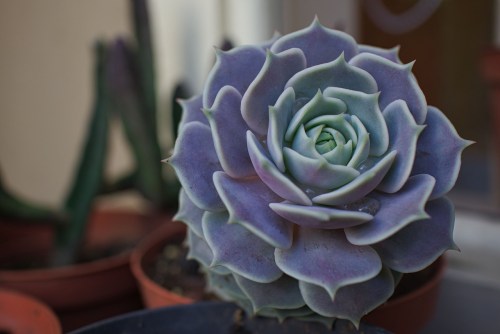
Succulents are popular houseplants, thanks to their easy care requirements and the wide range of sizes, shapes, and colors they grow in. When it comes to picking the best indoor succulents for your home, the amount of options can be overwhelming. If you’re looking for a good place to start, this is the list for you.
These five succulents are perfect indoor houseplants, great for beginners, and beautiful to look at. No matter what type of succulent appeals to you or what your home is like, one of these indoor succulents will be a great fit for you and your home.
Echeveria
Echeveria is a classic choice, and it may even be the first one you picture when hearing the word succulent. It has fleshy leaves that come in shades of green and pink that grow in circular patterns called rosettes. There are many kinds of echeveria, ranging in size and color, so there’s sure to be one that fits your needs.
This succulent can grow indoors and outdoors, so it’s a good choice if you want to be able to move your plant outside during warm weather. As long as it has a sunny windowsill to sit on and an occasional drink of water, your echeveria will be content.
Aloe vera
Aloe vera is not just an easy plant to grow indoors, but it’s also a useful one. Aloe is often used to soothe sunburns and scrapes, so having a supply of it growing in your home is handy. There are also other aloe species with unique shapes, patterns, and flowers, although these are less useful for cooling sunburns.
To keep your aloe vera thriving, place it in bright, indirect light. Near a window with a gauzy curtain or on a table slightly away from the window are good options for your aloe. Additionally, aloe vera needs more regular waterings than other succulent types. If you often find yourself overwatering succulents by mistake, growing aloe vera might be a better fit for your gardening style.
Ox tongue
Ox tongue succulents, also called gasteria, are a fun choice if you’re looking for a more unique succulent. Its common name comes from the shape of the leaves, which are oblong, ridged, and spotted with white. Ox tongue succulents are good office or dorm room indoor succulents, as they stay fairly small, grow slowly, and are tolerant of low lighting.
While many succulents become leggy and pale in low lighting, the impacts of low lighting on ox tongue succulents are slower growth and fewer flowers. The bigger issue for ox tongue succulents is water. They prefer dry soil and air, and they don’t fare well in high-humidity environments. Avoid getting their leaves wet when watering them.
String of pearls
String of pearls is a succulent that matches its name perfectly. The long stems and round leaves look like strings of green pearls draped over the side of the flowerpot. They are particularly beautiful in hanging baskets, which allow the stems to dangle off the sides, but they can grow in standing pots as well.
If pearls aren’t quite your aesthetic, you can also find its cousin, the string of dolphins succulent, at many nurseries. Both succulents enjoy full and partial sun, adapting well to most lighting situations. As with most succulents, they are sensitive to overwatering, so make sure to plant them in well-draining soil and a pot with drainage holes.
Panda plant
Panda plants are known for their soft, fuzzy leaves and stems. The leaves are oblong and tipped with brown dots, similar to that of bear paw succulents (another excellent choice for indoor succulents). Panda plants can actually grow to a couple feet tall when given enough space, but most indoor panda plants stay smaller.
They thrive in full sun and enjoy direct and indirect sunlight. Panda plants can become leggy if they don’t get enough sun, so pay attention to the way they grow and adjust as needed. Their fuzzy leaves are soft to the touch, but don’t get them wet. Panda plants are prone to developing leaf rot if their leaves are too wet. Take care to water them below their leaves, and only water them when the soil is dry.
Whether you prefer the simple, classic look of an echeveria, string of pearls, or aloe, or the more eccentric style of an ox tongue or panda plant, these five indoor succulents are a great starting place. Their easy care makes them perfect for beginners or busy gardeners. They are small enough to fit comfortably on a desk or windowsill, and they come in a variety of colors and shapes. These are our favorite indoor succulents, and hopefully, they will be yours as well.
Editors' Recommendations
- How to propagate fiddle-leaf fig plants: A step-by-step guide
- The best large indoor plants for an instant statement this spring
- How long does it take for a cactus to grow? Here’s what we know
- Now that it’s more common, here’s how to care for your sought-after Thai Constellation Monstera
- Can you grow plants in water beads? Here’s what you need to know